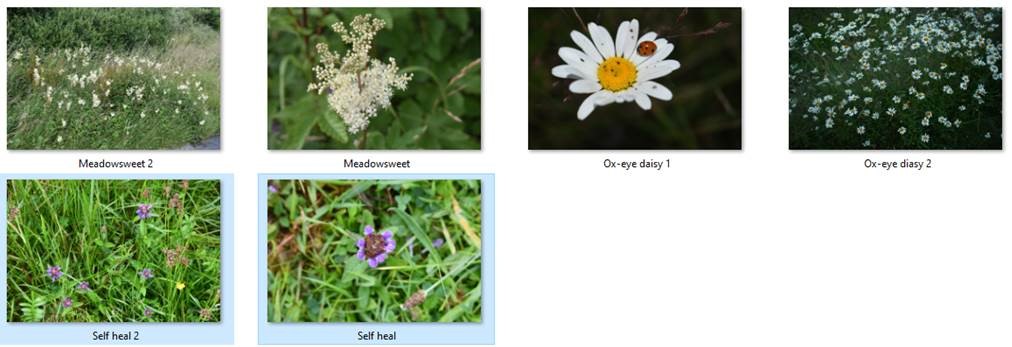09 July 2023
Growing Wild – Meadowsweet, Ox-eye Daisy and Selfheal

Now is the time to look out for Meadowsweet, Ox-eye Daisy and Selfheal, according to Catherine Keena, Teagasc Countryside Management Specialist, who takes a closer look at some of our native Irish biodiversity.
 Meadowsweet
Meadowsweet
One of the positive grassland indicator plants in ACRES, which agricultural advisors will be glad to see when scoring Low Input Grassland fields in ACRES General or fields in Cooperation Project areas. Leaves are silvery on the underside and have three to five pairs of larger leaflets with small leafy bits in between and the terminal leaflet is three lobed. Meadowsweet grows tall quickly and on long reddish stems produces frothy tiny white flowers, clustered in sprays shaped like a champagne flute. The sweetly scented pollen rich flowers attract insects, although they do not contain nectar. Meadowsweet is part of our native Irish biodiversity.
Ox-eye Daisy
Or dog daisy, which is another positive grassland indicator plant in ACRES. This familiar summer plant grows tall in drier grassland and flowers brightly all summer long. It is one of the first to recolonise disturbed ground. The lower leaves are oval and stalked while the upper ones are oblong and stalkless. The cluster of tiny yellow florets in the centre surrounded by larger white florets provide pollen and nectar to a wide variety of invertebrates which in turn become prey to other predatory invertebrates – bees, butterflies, moths, flies, beetles, ladybirds and spiders. Noinín mór is part of our native Irish biodiversity.
Selfheal
Look out for selfheal with purple-blue irregular flowers in whorls. Beneath the compact cylindrical flowerhead on a spike there are two leaves held at a slightly downward angle. While it is in the mint plant family it is unscented, but liked by bees and moths. A distinctive feature is the square stems. It grows low to the ground in short grassland where it spreads by creeping. One of seven key herbs in traditional medicine, selfheal was used by people to heal their own wounds. Another valuable indicator plant for farmers in ACRES – it is part of our native Irish biodiversity.
See previous Growing Wild articles below:
- Growing Wild – Marsh marigold and Ribwort plantain
- Growing Wild – Dandelions and cowslips
- Growing Wild – Lesser Celandine and Ivy berries
- Growing Wild – Winter Heliotrope and frogspawn
- Growing Wild – Willow Catkins and Birds Nests
- Growing Wild – Harts Tongue and Hazel
- Growing Wild – Whins and Ferns
- Growing Wild – Rose Hips and Flowering Ivy
- Growing Wild – Yarrow and Herb Robert
- Growing Wild – Elderberries and Blackberries
- Growing Wild – Haws and Spindle
- Growing wild – Guelder Rose and Sloes
- Growing wild – Purple loosestrife and Lord and Ladies
- Growing Wild – willowherb and water mint
- Growing Wild – dandelion and greater stitchwort
- Growing Wild – willow, primrose and lady’s smock
- Growing Wild – whitethorn and cow parsley
- Growing Wild – bluebells and guelder rose
- Growing wild – Honeysuckle and Foxglove
- Growing Wild – Elder and Ragged Robin
- Growing wild – dog rose and meadowsweet
- Growing wild – Privet and Lady’s Bedstraw
- Growing Wild – Bird’s foot trefoil and Knapweed
Keep an eye on Teagasc Daily for Growing Wild updates. Learn more from Teagasc about Biodiversity and Countryside here.
